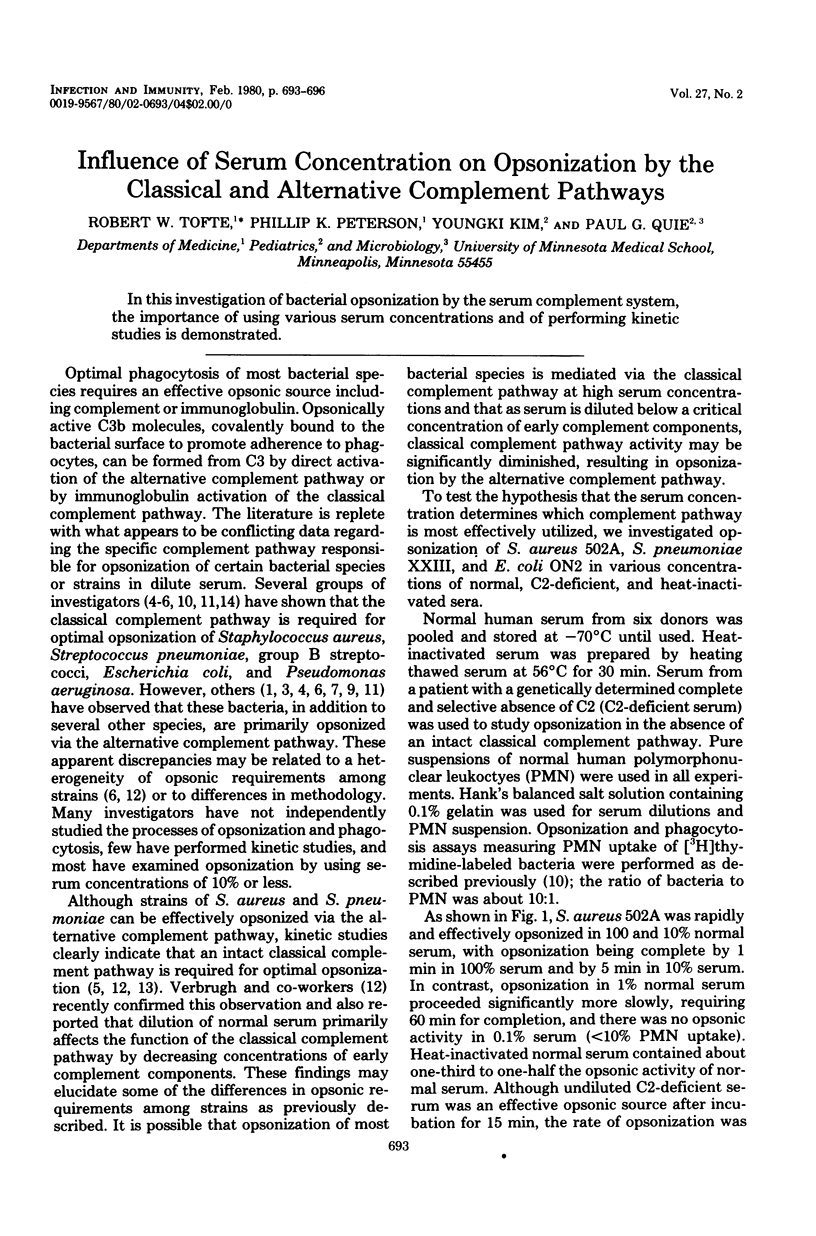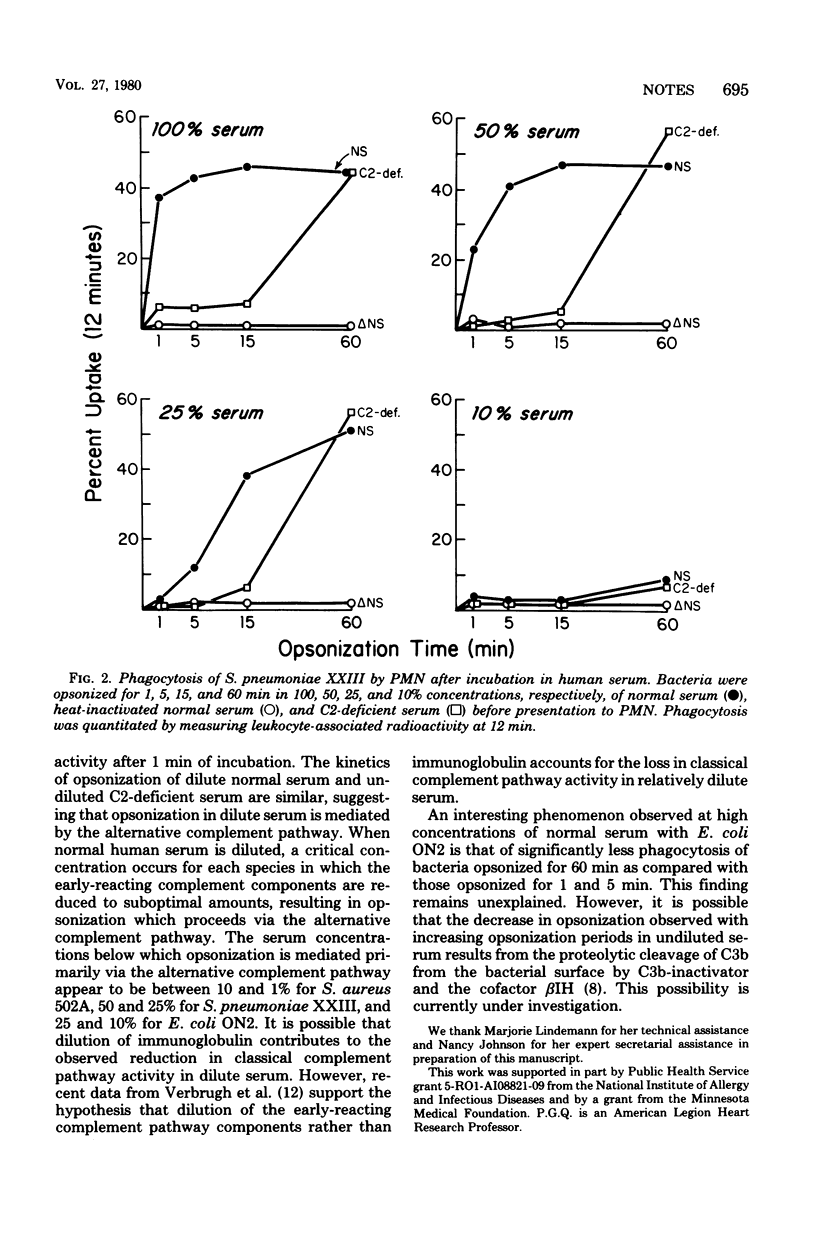Abstract
In this investigation of bacterial opsonization by the serum complement system, the importance of using various serum concentrations and of performing kinetic studies is demonstrated.
Full text
PDF



Selected References
These references are in PubMed. This may not be the complete list of references from this article.
- Bjornson A. B., Bjornson H. S. Participation of immunoglobulin and the alternative complement pathway in opsonization of Bacteroides fragilis and Bacteroides thetaiotaomicron. Rev Infect Dis. 1979 Mar-Apr;1(2):347–356. doi: 10.1093/clinids/1.2.347. [DOI] [PubMed] [Google Scholar]
- Björkstén B., Bortolussi R., Gothefors L., Quie P. G. Interaction of E. coli strains with human serum: lack of relationship to K1 antigen. J Pediatr. 1976 Dec;89(6):892–897. doi: 10.1016/s0022-3476(76)80592-6. [DOI] [PubMed] [Google Scholar]
- Forsgren A., Quie P. G. Influence of the alternate complement pathway in opsonization of several bacterial species. Infect Immun. 1974 Aug;10(2):402–404. doi: 10.1128/iai.10.2.402-404.1974. [DOI] [PMC free article] [PubMed] [Google Scholar]
- Giebink G. S., Verhoef J., Peterson P. K., Quie P. G. Opsonic requirements for phagocytosis of Streptococcus pneumoniae types VI, XVIII, XXIII, and XXV. Infect Immun. 1977 Nov;18(2):291–297. doi: 10.1128/iai.18.2.291-297.1977. [DOI] [PMC free article] [PubMed] [Google Scholar]
- Guckian J. C., Christensen W. D., Fine D. P. Evidence for quantitative variability of bacterial opsonic requirements. Infect Immun. 1978 Mar;19(3):822–826. doi: 10.1128/iai.19.3.822-826.1978. [DOI] [PMC free article] [PubMed] [Google Scholar]
- Jasin H. E. Human heat labile opsonins: evidence for their mediation via the alternate pathway of complement activation. J Immunol. 1972 Jul;109(1):26–31. [PubMed] [Google Scholar]
- Law S. K., Fearon D. T., Levine R. P. Action of the C3b-inactivator on the cell-bound C3b. J Immunol. 1979 Mar;122(3):759–765. [PubMed] [Google Scholar]
- Peterson P. K., Kim Y., Schmeling D., Lindemann M., Verhoef J., Quie P. G. Complement-mediated phagocytosis of Pseudomonas aeruginosa. J Lab Clin Med. 1978 Dec;92(6):883–894. [PubMed] [Google Scholar]
- Shigeoka A. O., Hall R. T., Hemming V. G., Allred C. D., Hill H. R. Role of antibody and complement in opsonization of group B streptococci. Infect Immun. 1978 Jul;21(1):34–40. doi: 10.1128/iai.21.1.34-40.1978. [DOI] [PMC free article] [PubMed] [Google Scholar]
- Stevens P., Huang S. N., Welch W. D., Young L. S. Restricted complement activation by Escherichia coli with the K-1 capsular serotype: a possible role in pathogenicity. J Immunol. 1978 Dec;121(6):2174–2180. [PubMed] [Google Scholar]
- Verbrugh H. A., Van Dijk W. C., Peters R., Van Der Tol M. E., Peterson P. K., Verhoef J. Staphylococcus aureus opsonization mediated via the classical and alternative complement pathways. A kinetic study using MgEGTA chelated serum and human sera deficient in IgG and complement factors C1s and C2. Immunology. 1979 Mar;36(3):391–397. [PMC free article] [PubMed] [Google Scholar]
- Verhoef J., Peterson P., Kim Y., Sabath L. D., Quie P. G. Opsonic requirements for staphylococcal phagocytosis. Heterogeneity among strains. Immunology. 1977 Aug;33(2):191–197. [PMC free article] [PubMed] [Google Scholar]
- Young L. S., Armstrong D. Human immunity to Pseudomonas aeruginosa. I. In-vitro interaction of bacteria, polymorphonuclear leukocytes, and serum factors. J Infect Dis. 1972 Sep;126(3):257–276. doi: 10.1093/infdis/126.3.257. [DOI] [PubMed] [Google Scholar]


